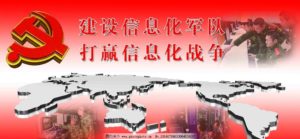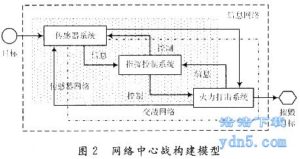中國“網絡中心戰”:讓未來戰場占主導地位
China’s “Network-centric warfare”: let the future battlefield dominate
“Network-centric warfare” is an important symbol in the process of the evolution of the mechanized war form to the information war form. It is the advanced form of the joint operation of the information age. It is a new mode of warfare on the information warfare platform which is relatively “platform center war” At present, from the “network-centric warfare,” the real arrival, although there is a long distance, but with its gradual maturity and rise, will inevitably lead to revolutionary changes in the future battlefield.
Combat operations from “asynchronous” to “synchronization”
The operations of the mechanized era are the same as the production lines of the industrial age, and there is usually a clear sequence of stages, such as firepower preparation, assembly and entry, and the first echelon attack. In the sequence of operations, due to the lack of real-time information can not grasp the battlefield, let alone the information sharing between the various forces, so the process of combat, mutual action can only be pre-planned asynchronous collaboration. In the “network center war”, the entire battlefield is a “information grid”, “sensor network” and “war network” composed of interconnection, seamless connection, dynamic open integrated network, commanders at all levels through The network can continue to perceive the entire battlefield situation, the full access to the battlefield information, and the use of the network to obtain information on the rapid processing, the development of operational plans and the issuance of operational orders, combat operations at all levels of the network at the same time almost at the same time get the same information, The command and order of the superior commander, according to the “network” to act, thus a high degree of autonomy to implement operations, to achieve operational synergy with self-synchronization.
Power concentration from the “quantity” to “system”
Since ancient times, the principle of concentrated forces has been regarded as the combat power of the military forces of the golden rule. The history of large-scale naval warfare, air combat and land brigade combat, concentrated tens of thousands of troops to fight the battlefield battle case too numerous. However, in the information age, the use of combat forces will be a series of major changes. In the “network-centric warfare”, the army became a complex and large-scale integrated system consisting of a number of command and control systems, battlefield awareness systems and weapons systems, in order to manage such a system and make it most efficient And give full play to the power and potential of the system, it must be information network technology as a link to the battlefield operation of the various functional systems highly integrated, into an organic whole, the formation of a high-performance war power system. This is by the traditional number of concentration can not be achieved, we must rely on the highly integrated system. Highly integrated combat system can make the theater, battlefield, warriors at all levels through the digital network, linked into a string of closely related chain, so that a general through the screen to see the fighting scene, a soldier can also see from his monitor , And thus achieve different combat forces, different levels of command of the real joint.
Combat group from “hard link” to “soft connection”
The general joint operations, to achieve only the combat entities of the “hard” connection, and “network-centric” approach, through the computer network as the core of the wide-area distribution, seamless connection, dynamic open integrated network system, not only To achieve combat entities “hard” connection, but also to achieve “combat procedures”, “operating mechanism” of the soft connection. Therefore, the “network-centric warfare” is a high-level form of joint operations in the information age, in this battlefield, land, sea, air and other military (soldiers) kind of block-like division of the group has no practical significance, the battlefield all combat units Are integrated network system in an equivalent cell, while the perception of the various states of the battlefield. Therefore, in the “network-centric warfare” approach, the combat group structure will be more grouped by ability, according to the need for joint “useful” combination. The so-called grouping by ability, that is, to break the boundaries of military and civilian forces will have the same combat capability of the unified grouping, thus greatly reducing the arms and arms between the overlap and waste; the so-called joint need, is based on the actual needs of combat, to have different Combat capability of the troops together, the joint operations.
Logistics support from “build” to “focus”
“Network-centric warfare” under the battlefield, will show a typical multi-dimensional, non-linear and non-contact characteristics. Logistics forces to build a large number of traditional means of protection, in this battlefield environment, will appear extremely cumbersome and discomfort. And the information, materials and transportation technology into one, through the automated supply network system to track and master the flow of a variety of materials and the demand situation of the troops, the required logistical supplies in a timely manner to the strategy, campaign and tactical units of the ” Focus “logistics, will become” network-centric warfare “in the logistics of the inevitable choice.
“Network center war” mode, the entire battlefield is a computer network technology as the core of the intelligent integrated system, through a highly integrated and highly intelligent information network, can achieve information, materials and transportation technology integration; through the combat Troops on the various sites to access the computer system, the security sector can grasp the needs of combat forces in real time, the combat forces can also real-time understanding of combat materials consumption and supplement the situation, so that real-time as needed to the required direction Materials, and to keep track of the material throughout. To ensure that logistical support is more accurate, flexible and accurate in terms of time, location and quantity.
Combat mission from “stability” to “change”
On the traditional battlefield, due to the weak sense of the battlefield, from the discovery of the target to attack the target reaction is slow, combat mission allocation is mostly planned, the middle rarely change. In the “network-centric warfare” approach, due to the battlefield perception, command and control and fire strike has become a whole, from the discovery of the target to the implementation of the attack time difference is getting smaller, near real time, the commander can change the battlefield situation, at any time To carry out dynamic adjustment and redistribution of the tasks of the troops, so as to maximize the operational potential of combat troops. In the Iraq war, the US military used its advanced and powerful information and network technology to reduce the time from the discovery of the target to the completion of the attack from the Gulf War 3 days, 2 hours of the Kosovo war to tens of minutes. And the real realization of the “network-centric warfare”, the reaction time will be further reduced or even reached in seconds to calculate, which makes the commander of the battlefield can make a quick change, more sensitive response, timely and efficient command, Control and coordination, greatly improving the ability to temporarily change the operational response to the rapid response. (Liu Yushan)
“China Defense News” July 1, 2004
Original Mandarin Chinese:
“網絡中心戰”是機械化戰爭形態向信息化戰爭形態演變過程中的一個重要標誌;是信息時代聯合作戰的高級形態;是相對“平台中心戰”的信息化戰場上的一種新型作戰模式,目前,離“網絡中心戰”的真正到來雖然還有較長距離,但隨著它的逐漸成熟和崛起,必將引起未來戰場的革命性變革。
作戰行動由“異步”轉向“同步”
機械化時代的作戰行動與工業時代的流水線生產一樣,通常是有明顯階段性的順序,如依次進行火力準備、集結與開進、第一梯隊發起攻擊等。在順序作戰中,由於無法掌握戰場實時信息,更談不上各部隊之間信息共享,因而作戰過程中,相互之間的行動只能按預先計劃進行異步協同。而在“網絡中心戰”中,整個戰場是一個由“信息柵網”、“傳感器網”和“交戰網”組成的互連互通,無縫連接,動態開放的綜合網絡,各級指揮員通過網絡能夠持續不斷地感知整個戰場態勢,全面獲取戰場信息,並利用網絡對獲取的信息進行快速處理,制定作戰計劃和發布作戰命令,各級作戰部隊通過網絡幾乎可在同時獲得同樣的信息,了解上級指揮員的意圖和指令,依“網”行事,從而高度自主地實施作戰,實現作戰協同自我同步。
力量集中由“數量”轉向“系統”
自古以來,集中兵力原則一直被兵家奉為作戰力量運用的金科玉律。歷史上大規模海戰、空戰和陸上大兵團作戰,集中成千上萬部隊進行戰場廝殺的戰例不勝枚舉。然而,在信息時代,作戰力量的運用將發生一系列重大變化。在“網絡中心戰”中,軍隊成為了一個由眾多指揮控制系統、戰場感知系統和打擊武器系統等構成的複雜而又龐大的綜合體系,要想駛馭這樣一個體系,使之最有效地運轉並充分發揮各系統的威力和潛能,就必須以信息化網絡技術為紐帶,把戰場運行中的各個功能係統高度集成,聯結成一個有機的整體,形成一種高效能的戰爭力量體系。這一點靠傳統的數量集中是無法實現的,必須依靠系統的高度集成。高度集成化的作戰系統可使戰區、戰場、戰士各個層面通過數字化網絡,聯結成一串息息相關的鏈條,使一個將軍通過視屏所看到的戰鬥景象,一個士兵也同樣能從他的顯示器中看到,進而實現不同作戰力量、不同指揮層次的真正聯合。
作戰編組由“硬聯接”轉向“軟聯接”
一般的聯合作戰,實現的只是各作戰實體的“硬”連接,而“網絡中心戰” 方式下,通過以計算機網絡為核心的廣域分佈,無縫連接,動態開放的綜合網絡系統,不僅可實現作戰實體的“硬”連接,而且可實現“作戰程序”、“運行機制”的軟連接。因此,“網絡中心戰”是信息時代聯合作戰的高級形態,在這種戰場上,陸、海、空等各軍(兵)種條塊式的區分編組已無實際意義,戰場上所有作戰單元都是綜合網絡系統裡的一個等同的細胞,同時感知著戰場的各種狀態。因此,在“網絡中心戰”方式下,作戰編組結構更多的將是按能力編組、按需要聯合的“有用”組合。所謂按能力編組,就是打破軍兵種界限將具備同樣作戰能力的部隊統一進行編組,從而大大減少各軍兵種力量之間的重疊和浪費;所謂按需要聯合,就是根據作戰的實際需要,把具備不同作戰能力的部隊組合起來,進行聯合作戰。
後勤保障由“集結”轉向“聚焦”
“網絡中心戰”下的戰場,將呈現出典型的多維性、非線性和非接觸性特點。後勤部隊大量集結進行保障的傳統方式,在這種戰場環境下,將顯得極為笨重和不適。而將信息、物資和運輸技術融為一體,通過自動化補給網絡系統,跟踪和掌握多種物資的流動和部隊的需求狀況,將所需的後勤物資及時發放到各戰略、戰役及戰術單位的“聚焦”式後勤,將成為“網絡中心戰”中後勤保障的必然選擇。
“網絡中心戰”方式下,整個戰場是一個以計算機網絡技術為核心的智能化的綜合系統,通過高度集成和高度智能化的信息網絡,可實現信息、物資和運輸技術一體化;通過在作戰部隊機動的各個站點上接入計算機系統,可使保障部門實時掌握作戰部隊的需要,作戰部隊也能實時了解作戰中物資的消耗和補充情況,從而做到實時按需要向多個所需方向運送物資,並保持對物資的全程跟踪。確保後勤保障在時間上、地點上和數量上的精確,使後勤保障更加及時、靈活和準確。
作戰任務由“穩定”轉向“多變”
傳統戰場上,由於戰場感知能力弱、從發現目標到攻擊目標反應慢,作戰任務分配多是預先計劃,中間很少有變。而在“網絡中心戰”方式下,由於戰場感知、指揮控制和火力打擊已成為一個整體,從發現目標到實施攻擊的時差越來越小,近乎實時,指揮員可以根據戰場態勢的變化,隨時對部隊的任務進行動態的調整和重新分配,從而最大限度地發揮作戰部隊的作戰潛能。伊拉克戰爭中,美軍運用其先進和強大的信息及網絡技術,使戰場上從發現目標到完成攻擊的時間從海灣戰爭時的3天,科索沃戰爭時的2小時縮短至幾十分鐘。而真正實現“網絡中心戰”後,這一反應時間還會進一步縮短甚至達到以秒來計算,這使得指揮員可對戰場的瞬息變化作出更快、更靈敏的反應,及時高效地進行指揮、控制與協調,大大提高臨時改變作戰計劃的快速反應能力。 (劉玉山)
《中國國防報》 2004年07月01日

